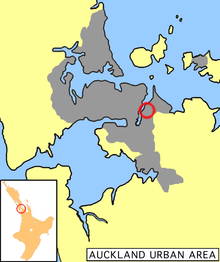Pakuranga, New Zealand
| Pakuranga | |
|---|---|

Pakuranga, looking east (the suburb is the "peninsula"-shape on the far side of the Tamaki River)
|
|
 |
|
| Basic information | |
| Local authority | Auckland Council |
| Population | 30,340 (2006) |
| Surrounds | |
| North | (Tamaki River), Glen Innes |
| Northeast | Sunnyhills |
| East | Botany |
| Southeast | East Tamaki |
| South | (Tamaki River) |
| Southwest | (Tamaki River), Otahuhu |
| West | (Tamaki River), Mount Wellington |
| Northwest | (Tamaki River), Panmure |
Pakuranga is an eastern suburb of Auckland, in northern New Zealand. Pakuranga covers a series of low ridges and previously swampy flats, now drained, that lie between the Pakuranga Creek and Tamaki River, two estuarial arms of the Hauraki Gulf. It is located to the north of Manukau and 15 kilometres southeast of the Auckland CBD.
The suburb's name is Te Pakūrangarāhihi Maori for battle of the sunlight or battle of the sun's rays. A fierce battle over forbidden love raged between two patupaiarehe - fairy people of the forest - until a priest caused the sun to rise and the earth to explode. Caught by the rays of the sun and volcanic eruptions, many patupaiarehe perished..
Pakuranga is traditionally home to the Ngāi Tai Iwi also known as Ngāi Tai Ki Tāmaki. The prominent pa were at Ohuiarangi / Pigeon Mountain and Mokoia Pā of Ngāti Paoa at Panmure on a cliff, at the intersection of the Te Wai Ō Taiki / Tamaki River and the inlet to the Panmure Basin. During the attacks by Ngapuhi in the Musket wars in late September 1820, most of the population were killed, taken prisoner or fled south to the Waikato.
In early European times, it was a sparsely settled dairy farming area between the townships of Panmure and Howick. In the 1920s and 30s it was served by a bus that ran from Bucklands Beach known as the "shiek". In the 1930s a concrete road was built between these townships that improved transport times for people and milk. Although there had been a hinged steel bridge over the Tamaki River to Panmure from as early as 1866, it was not until the construction of a sturdier structure across the Tamaki River in the 1950s, coinciding with a demand for more settlement land and the increasing levels of car ownership, that Pakuranga became suburban. In fact, for a while in the 70s it was considered the typical New Zealand middle class suburb, 'Vim Valley', after 'a typical Pakuranga housewife' was featured in a famous cleaning product ad.
Many of the American style houses of the 1950s and 1960s are still noticeable but much of the appeal of the early suburb lay in the proximity of untouched countryside. Since the 1970s Pakuranga has been surrounded and engulfed by suburban developments on a much larger scale but of less architectural merit. Traffic travelling to and from these suburbs and the centre of Auckland is largely funnelled through the roadways of Pakuranga which has degraded the area somewhat as well.
...
Wikipedia
